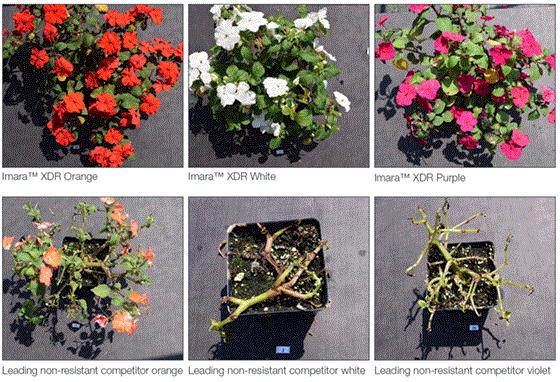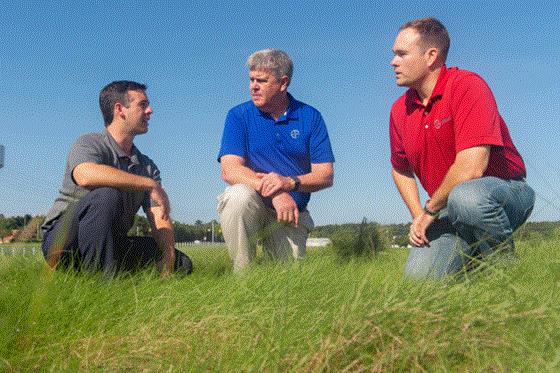Snow down south
Before I dive into the news, I want to know if any of you Southeast-U.S. growers have gotten a dumping of snow like you’ve never seen before? I've seen news images that make North Carolina look like North Dakota! (Well, North Dakota in November).
If so, can you send me a good picture of your business buried under the white stuff (hopefully looking Christmas card-pretty, not insurance-claim damaged)?
Email it to beytes@growertalks.com. Make sure it’s horizontal, and high-resolution. The prettier and more interesting, the better. Include a few notes about the storm. I might just use it in an upcoming issue!
Now, on to the news:
Syngenta to launch IDM-resistant impatiens at Spring Trials
It’s called Imara XDR, and it will be the first impatiens downy mildew-resistant impatiens to get a full launch into the U.S. market, at Syngenta’s California Spring Trials exhibit next March.
Imara XDR will be competing with PanAmerican Seed’s Beacon impatiens, which is getting a soft launch in 2019 and a full launch in 2020.
I got the details on Imara XDR from Scott Valentine, Syngenta’s top guy in the Flowers division, whom I’d emailed after hearing continued rumors about a Beacon competitor.
Scott confirmed the news above, adding that they launched it in Europe this past spring for the UK (which was very hard hit by IDM). “We have full commercial production of seed in the bag—the product is ready to go!” he stated.
As for where the name “Imara” comes from? It’s Swahili for “strength and resilience” he says.
Knowing I’d have some more hard-hitting technical questions to ask, Scott turned me over to the California-based Olivia Sellards, Syngenta’s effervescent Customer Marketing Manager, who employed the classic surfer term “stoked” to describe Syngenta’s enthusiasm for their new product.
First, a couple of definitions: XDR means “extra disease resistance” and will be attached to one additional crop this spring (more on that later). To be labeled XDR, the genetics must be proven to be resistant to whatever disease they are labeling it for, as verified through rigorous testing in multiple settings and situations. And the disease resistance has to be independently verified by third-party experts.
Second, how is Syngenta classifying Imara XDR’s resistance abilities? PanAmerican Seed is saying Beacon impatiens has “high resistance” to IDM based upon a technical designation approved by the International Seed Federation (ISF).
Olivia also used the term “highly resistant,” but didn’t go so far as to reference ISF. She did say that Cornell pathologist Margery Daughtrey, one of the independent testers, has classified Imara that way. Via email, Margery confirmed that, writing:
“I am comfortable with calling the Imara XDR impatiens ‘highly resistant’ because not only were the symptoms and signs measurably (statistically) lower than those of the highly susceptible plants they were compared to, but the plants also looked good to the naked eye rather than collapsing from downy mildew.”
Margery said she made quality ratings weekly on Imara XDR impatiens exposed to downy mildew: they maintained their foliage and flowers throughout two replicated trials in which susceptible “control” cultivars defoliated and melted away. She says she made sure that the disease pressure was high by putting infected plants into the area to provide airborne inoculum, supplying overhead irrigation twice a day and giving plants 50% shade to provide conditions favorable to disease development.
 Imara in Cornell trials, where it was exposed to diseased plants for two months.
Imara in Cornell trials, where it was exposed to diseased plants for two months.
Said Margery, “Good performance by an impatiens under those conditions was exciting to see. The plants were not immune to the pathogen, but they held up very well in its presence—they are highly resistant.”

Details on the variety
With the all-important IDM-resistance question answered, what about Imara XDR as an impatiens series? Well, answered Olivia, Imara is all new breeding, not just a sport or selection of an existing series. Senior Flower Breeder Ton Groot says it was 2011 when he found the plant that all the work is based on.
Olivia says Imara is most similar in habit to Accent Premium, Syngenta’s long-running series that came through the Goldsmith acquisition. Imara will start with seven colors and a mix; as many as three more colors will be added by Spring Trials 2019.
The variety was bred in the Netherlands; seed production is taking place in Guatemala. Some growers are already doing production trials. Imara’s public debut will take place at Costa Farms’ Season Premier Trial. After that, you’ll see it at all Spring Trials and all the summer shows. There will be loads of educational, information and promotional activities associated with the launch. I’m assured there’s plenty of seed in the bag to meet demand.
As for cost, Olivia says there will be a “slight” price premium over regular I. walleriana. But it doesn’t sound like it will be objectionable.
“We’re pricing it so that it’s economical to grow,” she says. “We want people to bring back impatiens … our tagline for this product is ‘Take back the shade!’”
Except in the UK, that is, where the tagline has been “Busy Lizzies are back!”

The other XDR
This one would make big news on its own were it not for the introduction of Imara XDR. It’s Cora XDR vinca, an upgrade of Cora, which was introduced way back in 2007 touting excellent aerial phytophthora resistance. Cora XDR beats that by a mile, with resistance to up to 12 strains of phytophthora.
Says Olivia in her California way: “Cora is good; the next generation Cora XDR will blow your socks off!”
Speaking of Spring Trials
They’re early this year: March 23-27. Which means Jen Zurko is already pestering me about our travel plans. She does all the work on keeping our www.springtrials.com website up to date, and I asked her to share what she knows about additions, subtractions and musical greenhouses. Here’s what she supplied:
- Floranova will no longer be at Green Fuse in Santa Paula since they were bought by Syngenta, so they’ll be with them in Gilroy
- Westhoff, Elsner-PAC, TO Plastics and KOBA Corp. will take Floranova’s place, joining Green Fuse in Santa Paula
- Terra Nova is moving from the stop at Windmill Nursery in Buellton to Pacific Plug & Liner in Watsonville
- Bailey has decided to skip Spring Trials this year, so won’t be at Pacific Plug & Liner
- Beekenkamp will be the only company exhibiting at Floricultura in Salinas
- So far, GroLink has 11 companies exhibiting; last year they had 14
That means 16 stops—same as last year. As for how many companies total, well, we’ll have to wait for the music to stop and the dust to settle.

Webinar: The Buglady on Beneficials
The latest GrowerTalks webinar is about the latest developments in the world of beneficial nematodes. They are more popular than ever, but there are some things the beneficial nematode users should know. That’s why you should attend “Beneficial Nematodes: Where Are We?” slated for Thursday, December 13 at 1 p.m. Eastern.

Who better to talk about beneficial nematodes (or any sort of beneficials, for that matter) than Suzanne “Buglady” Wainright. Suzanne will be joined by BASF scientist Julie Graesch, and both will discuss all matters beneficial nematode, such as:
- The commercially available nematode species
- Their biology and target pests
- Available formulations
- How to get the most out of your nematode applications
- What’s new in research
Join Suzanne, Julie and me for this FREE webinar, taking place Thursday, December 13 at 1 p.m. Eastern (noon Central). Register for it over at www.growertalks.com/webinars.
Special thanks to BASF for putting the “free” in free webinar!

Bayer facility wins community award
The Research and Educational facility of Bayer Environmental Science has been recognized by Clayton, North Carolina, for achieving “exceptional success through service to their customers and the community.” That’s a high honor for a neighborhood (Research Triangle Park) that is loaded with exceptional companies doing exceptional work.
Said Jake Doskocil, Ph.D., Bayer Clayton site manager and principal scientist, “The research and development efforts at the Clayton facility are fundamental to the discovery of new solutions and cutting-edge expertise for our customers across the globe.”
The 278-acre Bayer Research and Education Facility in Clayton, which has been in operation since 1957, hosts more than 50 events every year and welcomes more than 1,000 customers, university experts and other industry professionals as part of its ongoing commitment to customer centricity, sustainability, stewardship and product development. In 2018, the development staff at the facility conducted more than 160 biology-based trials in their laboratory, greenhouse and field to test and measure the efficacy of insect, disease and weed management technologies. Of Bayer’s three Centers of Excellence (the others are in Germany and Brazil), this is the only one that specializes in turf and ornamentals.

Jake Doskocil, PhD (right) and Laurence Mudge (center) talking with a Bayer customer (left) in the field at the Bayer Research and Education Facility in Clayton, North Carolina.

Research proposal reviewers needed
Want to influence how federal dollars are spent on horticultural research? Then volunteer to be a reviewer of Specialty Crop Research Initiative (SCRI) proposals.
Huh?
You see, we as the specialty crop industry asked that research proposals for our segment get reviewed by industry experts to make sure the research topic is timely and relevant to what we need. Congress ok’d our request and put the requirement into the 2014 Farm Bill. Now USDA is seeking help to accomplish this review.
Who can be a reviewer?
Anyone who works in any aspect of horticulture, from production to end-use, from retail to tree care professionals, industry association representatives, or anyone engaged in the production, handling, processing, distributing or sale of specialty crops (in the U.S., of course).
How does it work?
Volunteers read and evaluate up to 15 Stakeholder Relevance Statements (SRS) and submit reviews in NIFA’s online Peer Review System. There’s no need to travel to participate.
Next, you’ll participate in a review panel conference call of approximately one hour to agree on ranking of proposals with each topic group.
The estimated time commitment is between 10 and 15 hours.
Typical timeframe for reviews is December and January of each year.
I learned about this from the National Initiative for Consumer Horticulture (NICH), which is specifically seeking folks with consumer horticulture experience to help out—in other words, to make sure consumer research is focused in the most appropriate way. But their request applies to all aspects of horticulture.
The NICH request included a quote from Mary Kay Woodworth, executive director of Urban Ag Council, who has participated in the review process.
“I guarantee you will find it interesting and exciting,” she says. “If you are like me, someone who scratches your head when you see the topics of some research grants that are funded, this is your opportunity to influence how your tax dollars are spent! I strongly encourage members of the urban ag industry to participate in the grant reviews. It’s a small amount of time commitment for potentially big investments in our industry!”
There’s another benefit: “Movers and shakers participate on these panels, so the networking is good.”
To sign up, visit this website: https://nifa.usda.gov/announcement/scri-relevance-review. You can also contact Dr. Tom Bewick, National Program Leader at tbewick@nifa.usda.gov.

Finally ...
Folks from outside our industry continue to try to bring the digital world to our products … or vice versa, as these two latest examples of plugged-in plants show:
Fast Company magazine reports on an MIT researcher who is using a plant’s leaves to act as light sensors, which in turn control a robot base that drives the plant toward the light source.
The idea isn’t to create self-driving plants that stay in a bright window (although there’s been research around that, too). Rather, it’s to show that plants can be used as an organic, living interface between the natural and digital worlds. How might that be used?
Says Fast Company, “Instead of using a light sensor in your office to ensure that employees are getting enough natural light, a plant hooked up to a computer could do just as good of a job. Similarly, plants could act like humidity or even air quality gauges. (And they’ll look a lot nicer on your desk than any gadget, too.)”
Aspara is yet another tabletop plant-growing device that touts LEDs, app-based controls, automatic watering and advanced sensors to create a miniature hydroponic farm “that does the growing for you.” They even guarantee 100% germination from their seed kits. (I’m sure breeders would love to know how they can do that!)
The only thing I like about this one is that the press release likens it to “A Keurig for your plants.”

Like most of these indoor gardening devices, it’s being funded on Kickstarter. Get yours for the early bird price of just $299 and never again worry about tainted lettuce.


See you next time,

Chris Beytes
Editor
GrowerTalks and Green Profit
This e-mail received by 23,303 loyal readers!
Thanks to my loyal sponsors, who help me reach the 23,303 readers of Acres Online in 66 countries. Want to be one of them (a sponsor, that is)? Give Paul Black a shout and he'll hook you up.